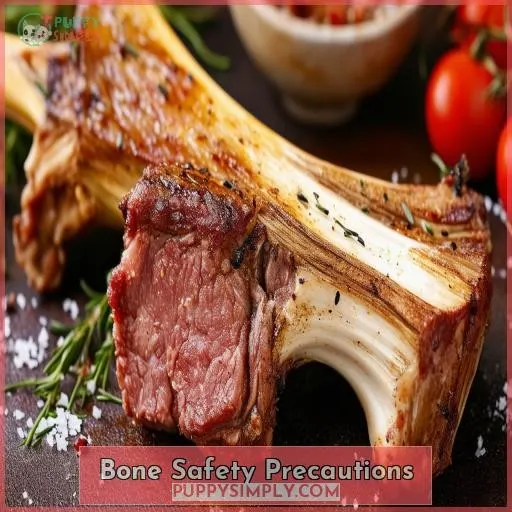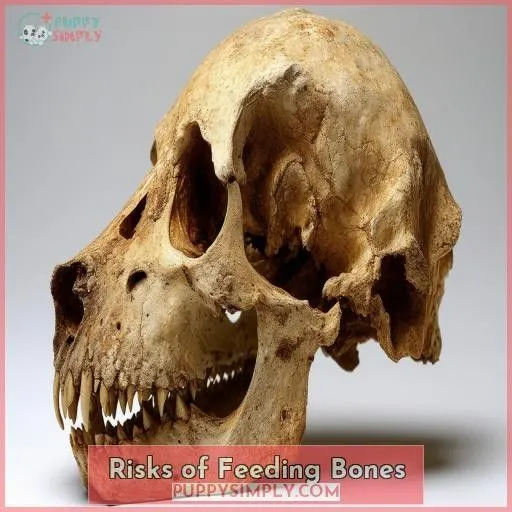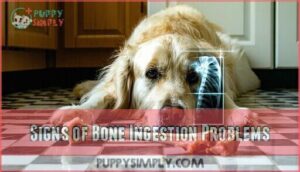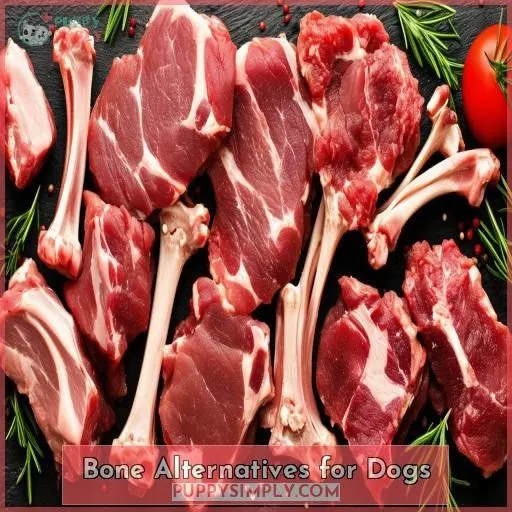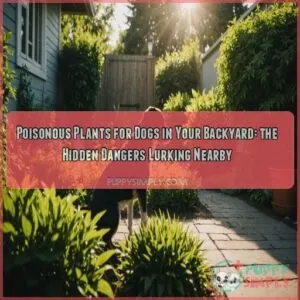This site is supported by our readers. We may earn a commission, at no cost to you, if you purchase through links.
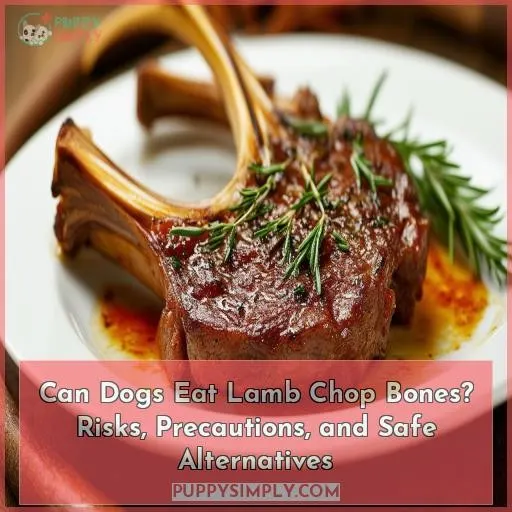 Feeding your dog lamb chop bones isn’t a good idea. Cooked bones, like lamb chops, can splinter easily, causing internal injuries, choking, or even gastrointestinal blockages.
Feeding your dog lamb chop bones isn’t a good idea. Cooked bones, like lamb chops, can splinter easily, causing internal injuries, choking, or even gastrointestinal blockages.
These risks outweigh the benefits, making them unsuitable for your pet. Stick with raw bones, which are harder and less likely to splinter, or consider alternatives like Nylabones, dental chews, and homemade frozen treats to keep your dog happy and safe.
Table Of Contents
Key Takeaways
- Steer clear of cooked lamb chop bones, as they’re a recipe for disaster – splintering and choking hazards galore!
- Raw bones are the safer choice, but keep a watchful eye on your furry friend while they’re chomping away.
- If your dog’s got tummy troubles, bones are a no-no – bone marrow can wreak havoc on their delicate digestive system.
- Treat your pooch to safer alternatives like Nylabones, dental chews, or homemade frozen treats to keep their teeth sparkling and their tails wagging.
Can Dogs Eat Lamb Chop Bones?
No, dogs shouldn’t eat lamb chop bones. Lamb chop bones can splinter and cause choking, digestive blockages, or internal injuries .
Bone Safety Precautions
When considering giving lamb bones to your dog, prioritize bone safety precautions.
Always choose large, hard bones that can’t get swallowed whole and never give cooked bones, as they splinter easily.
Raw bones are safer but can still pose risks; always supervise your dog and consult your vet if you’re unsure.
Avoid bones if your dog has GI issues, as bone marrow can trigger problems.
Monitor for signs of gastrointestinal obstruction like vomiting or lethargy, and keep bones out of their reach when unsupervised.
Consider using rawhide alternatives to provide your pet with nutritional value and chew satisfaction without the risks.
Types of Bones for Dogs
When choosing bones for your dog, it’s vital to understand the differences between raw versus cooked bones and edible versus chewable bones. Raw bones are generally safer as they’re less likely to splinter, while edible bones provide nutritional value but should be ground and mixed into food to avoid choking hazards.
Raw Vs. Cooked Bones
When considering lamb bones for dogs, always choose raw over cooked. Raw bones:
- Are harder and less likely to splinter
- Prevent choking and internal injuries
- Keep dental health in check
- Avoid bacterial contamination
Raw is safer!
Edible Vs. Chewable Bones
Edible bones are for nutrition and should be ground and added to food. Chewable bones are large, hard, and designed for recreation, not consumption. They shouldn’t be completely eaten to avoid digestive tract issues, soreness, or bloody stool.
Acceptable Bone Choices
When considering bones for your dog, keep these options in mind:
- Large lamb chop bones
- Hard beef bones
- Safe chew alternatives
- NylaBone for dental health
- Rawhide bones for sensitive stomachs
Choose wisely for safety.
Risks of Feeding Bones
Feeding your dog lamb chop bones can pose several risks, including splintering, which can cause internal injuries, and digestive tract blockages (Source). These bones can also damage teeth and gums, introduce harmful bacteria, and present choking hazards .
Splintering and Internal Injuries
Splintering bones can cause internal injuries, leading to gastrointestinal obstruction, difficulty eating, and contracting abdomen issues in dogs.
Digestive Tract Blockage
Feeding bones risks digestive tract blockage, leading to intestinal obstruction, vomiting, diarrhea, lethargy, constipation—ensure prompt veterinary care for your pet.
Dental and Gum Damage
Chewing on bones can lead to fractured teeth, gum disease, and tooth decay. Follow these precautions:
- Avoid giving cooked bones.
- Choose large, hard bones.
- Supervise chewing always.
Bacterial Contamination
B contamination from bones can wreak havoc on your dog’s gastrointestinal system, causing severe issues requiring prompt veterinary advice and care .
Choking Hazard
Choking is a serious risk. Always supervise your dog, offer safe bone sizes, and remove bones before they become swallowable.
Signs of Bone Ingestion Problems
If your dog ate a lamb chop bone, watch for signs of gastrointestinal obstruction like vomiting, loss of appetite, or lethargy. Other symptoms can include difficulty eating, excessive salivation, straining during defecation, and abdominal pain .
Gastrointestinal Obstruction Symptoms
Gastrointestinal obstruction symptoms from bone fragment ingestion include vomiting, lack of bowel movements, and lethargy. Diet changes and stress can exacerbate GI tract irritation. Watch for abdominal tenderness and excessive salivation, which could signal blockage. Immediate veterinary attention is imperative if these symptoms appear.
Internal Damage Indicators
You’ll notice several internal damage indicators if your dog ingests bones. Watch for:
- Abdominal pain: evident through excessive whining or whimpering.
- Ear discomfort: if the dog shows signs of irritation.
- Diarrhea: frequent or loose stools.
- Lethargy and withdrawal: reduced activity and social interaction.
Bone Alternatives for Dogs
After identifying signs of bone ingestion, it’s time to explore safer alternatives that keep your pup happy and healthy. Instead of bones, consider these:
- Artificial Chews: Nylabones are popular and designed to be durable and safe for chewing .
- Homemade Treats: DIY frozen dog treats are a great option for a delicious and healthy snack .
- Dental Chews: Aim for longer-lasting chews like those specifically made for dental health [citations:2](Source).
- Edible Toys: These provide both a source of entertainment and nutritional value without the risks associated with bones.
Utilizing these options can safeguard your dog’s safety and enjoyment.
Frequently Asked Questions (FAQs)
Are lamb chops good for dogs?
Lamb chops aren’t ideal for dogs. While lamb meat is nutritious, the bones can splinter, causing internal injuries or blockages. Always avoid giving dogs cooked bones and opt for safer alternatives like rawhide chews or specially designed dog treats .
What kind of bones can dogs eat?
Raw beef and lamb bones are safe for dogs, symbolizing robust health and joy. Verify they’re large and hard to avoid splintering hazards, and never give cooked bones, as they can cause severe injuries or obstructions .
Can dogs eat lamb raw?
Dogs can eat raw lamb bones, but it’s imperative to monitor them closely. Raw bones are less likely to splinter compared to cooked ones, reducing the risk of internal injuries, choking, and digestive tract blockages .
Can dogs digest bones?
Surprisingly, dogs can digest some bones, but it depends on type and preparation. Raw bones are generally safer as they’re less likely to splinter, whereas cooked bones can cause severe damage or blockages in your dog’s digestive tract .
Are lamb chop bones safe for puppies?
Lamb chop bones aren’t safe for puppies due to splintering risks and potential internal injuries. Always supervise closely, choose large, raw bones if necessary, and make certain they’re appropriate for your puppy’s size and chewing strength .
Can lamb bones help with dental health?
Lamb bones can help with your dog’s dental health by cleaning teeth, reducing plaque, and improving breath . They’re harder and less likely to splinter compared to cooked bones, offering a safer chewing option (Source).
How does bone size affect safety?
Bone size directly impacts dog safety, as larger bones are less likely to splinter and cause blockages, choking or injury. Smaller bones can be swallowed whole, leading to severe gastrointestinal issues and potential emergency situations .
Do lamb chop bones provide nutritional benefits?
Lamb chop bones might contain valuable nutrients like calcium and phosphorus but pose risks like splintering and causing internal injuries. Always prioritize your dog’s safety by avoiding giving them lamb chop bones to chew on .
Conclusion
Ultimately, prioritizing your dog’s safety and well-being is of utmost importance. Cooked lamb chop bones can pose significant risks, including splintering, choking, and internal damage.
As such, it’s imperative to avoid giving these to your pet. Instead, opt for raw bones, dental chews, or other safe alternatives.


